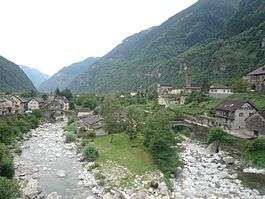Giornico
| Giornico | ||
|---|---|---|
|
Giornico village | ||
| ||
 Giornico | ||
|
Location of Giornico 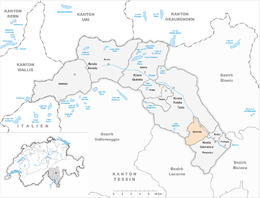 | ||
| Coordinates: 46°24′N 8°52′E / 46.400°N 8.867°ECoordinates: 46°24′N 8°52′E / 46.400°N 8.867°E | ||
| Country | Switzerland | |
| Canton | Ticino | |
| District | Leventina | |
| Government | ||
| • Mayor | Sindaco | |
| Area[1] | ||
| • Total | 19.48 km2 (7.52 sq mi) | |
| Elevation | 391 m (1,283 ft) | |
| Population (Dec 2015[2]) | ||
| • Total | 879 | |
| • Density | 45/km2 (120/sq mi) | |
| Postal code | 6745 | |
| SFOS number | 5073 | |
| Surrounded by | Anzonico, Bodio, Cavagnago, Chironico, Frasco, Personico, Sobrio | |
| Website |
website missing SFSO statistics | |
Giornico is a municipality in the district of Leventina in the canton of Ticino in Switzerland.
History
Giornico is first mentioned around 935-94 as de Iudicibus Giornicensis. In 1202 it was mentioned as Iornico, and around 1210-58 it was mentioned as Zurnigo. Formerly, it was known by the German names of Yrnis or Girnis.[3]
During the Middle Ages, the large Vicinanza of Giornico comprised 15-20 settlements or villages, which were distributed to several Degagne, the exact border of some are still unclear. This organizational structure remained until the formation of the Canton of Ticino in 1803. During the reign of the Milan Cathedral over the three valleys that followed the Ambrosian Rite in their worship services, Giornico was a regional administrative center. A court day was held in Giornico for the Leventina valley, which was a supplement to the Placita, the main meetings in Bodio.[3]
The plague struck Giornico several times including; 1484, 1566 and 1629 (265 victims).
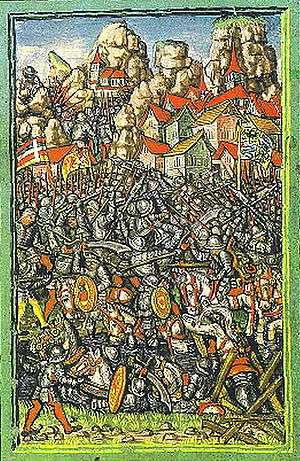
In the Battle of Giornico on 28 December 1478 a Swiss force of 600 defeated 10,000 Milanese troops.
By 1567, the local parish was independent, but the date of separation from the church in Biasca is not known. The Church of St. Nicholas, was built in the second decade of the 12th Century. With its remarkable capitals, it is the most important romanesque church in the canton. Originally it was part of a 15th Century Benedictine monastery.[3]
The parish church of S. Michele is first mentioned in 1210. During the Late Middle Ages it was rebuilt as a three-nave church. The three-nave church was replaced in 1787 by a one-nave church. The choir is from 1644, the bell tower is from 1861.
The church of S. Maria del Castello, with frescoes by an Seregneser master from 1448, was built in various stages at the site of a castle. The castle was probably built in the 12th Century by the da Giornico family and was destroyed in 1518 by the army of the Canton of Uri. The castle wall remains and portions of the keep have been preserved.
The church of S. Pellegrino at the old road to Chironico, was consecrated in 1345 and expanded in the 16th Century. It houses the largest collection of late Renaissance paintings in Ticino (Giovanni Battista and Domenico Tarilli Caresana, 1589). The Casa Stanga, an old inn from the 16th Century, is known for the facade, which was decorated in 1589 with the coat of arms of famous guests. Since 1972, the building houses the Museum of the Levantine. In the center there is a medieval tower, which according to tradition, was built by Saint Atto of Vercelli. The center of town is characterized by a row of houses from the 18th-19th Centuries.[3]
The town was damaged in 1868 by a flood, and in 1978, 1993 and 2000 by landslides. New barriers were built to prevent further landslides.

The old road over the Ticino river, has two stone arch bridges, and led on the right side of the valley. It bypassed the Biaschina gorge and ran toward the church of San Pellegrino. Today, the ravine is spanned by railway tunnels and the longest and highest viaduct, on the A2 motorway. The construction of the railway line in the 19th Century brought a loss of importance for Giornico. Because of the steep slope of the line (27‰) the construction of a station suitable for trade and transport was not possible.[3]
The favorable climate have made the cultivation of vineyards and chestnut possible. Originally a farming village that lived from the Gotthard road, the municipality has gradually changed to an industrial and residential town. Since the end of World War II, this trend has accelerated. The steel mills of the Monteforno company, which opened in 1946, closed at the end of 1994. The debate about the future of the abandoned area is still open. A revival of the industrial sector was experienced in 2002 when the maker of railway accessories, Tensol Rail AG from Piotta moved into the town. In 2002 its revenue was about 22.3 million francs.[3]
Geography

Giornico has an area, as of 1997, of 19.48 square kilometers (7.52 sq mi). Of this area, 1.01 km2 (0.39 sq mi) or 5.2% is used for agricultural purposes, while 11.86 km2 (4.58 sq mi) or 60.9% is forested. Of the rest of the land, 1.42 km2 (0.55 sq mi) or 7.3% is settled (buildings or roads), 0.4 km2 (0.15 sq mi) or 2.1% is either rivers or lakes and 5.08 km2 (1.96 sq mi) or 26.1% is unproductive land.
Of the built up area, industrial buildings made up 1.7% of the total area while housing and buildings made up 1.6% and transportation infrastructure made up 3.5%. Out of the forested land, 47.4% of the total land area is heavily forested, while 11.1% is covered in small trees and shrubbery and 2.4% is covered with orchards or small clusters of trees. Of the agricultural land, 2.7% is used for growing crops and 1.6% is used for alpine pastures. All the water in the municipality is flowing water. Of the unproductive areas, 11.2% is unproductive vegetation and 14.8% is too rocky for vegetation.[5]
The municipality is located in the Leventina district, at the foot of the Biaschina gorge and along the Ticino river. Its location along the Gotthard route, allowed the municipality to profit from travelers along the route. It grew into an important political and religious center in the lower Leventina valley.
Coat of arms
The blazon of the municipal coat of arms is Per fess Or and Gules overall three mullets, one and two, counterchanged.[6]
Demographics
Giornico has a population (as of December 2015) of 879.[2] As of 2008, 23.2% of the population are resident foreign nationals.[7] Over the last 10 years (1997–2007) the population has changed at a rate of -11.5%.
Most of the population (as of 2000) speaks Italian(93.6%), with Portuguese being second most common ( 2.3%) and German being third ( 1.6%).[8] Of the Swiss national languages (as of 2000), 14 speak German, 2 people speak French, 828 people speak Italian, and 2 people speak Romansh. The remainder (39 people) speak another language.[9]
As of 2008, the gender distribution of the population was 49.2% male and 50.8% female. The population was made up of 315 Swiss men (36.4% of the population), and 111 (12.8%) non-Swiss men. There were 347 Swiss women (40.1%), and 92 (10.6%) non-Swiss women.[10]
In 2008 there were 2 live births to Swiss citizens and 2 births to non-Swiss citizens, and in same time span there were 7 deaths of Swiss citizens and 1 non-Swiss citizen death. Ignoring immigration and emigration, the population of Swiss citizens decreased by 5 while the foreign population increased by 1. There were 2 non-Swiss men and 4 non-Swiss women who immigrated from another country to Switzerland. The total Swiss population change in 2008 (from all sources) was a decrease of 14 and the non-Swiss population change was a decrease of 10 people. This represents a population growth rate of -2.6%.[7]
The age distribution, as of 2009, in Giornico is; 56 children or 6.5% of the population are between 0 and 9 years old and 83 teenagers or 9.6% are between 10 and 19. Of the adult population, 72 people or 8.3% of the population are between 20 and 29 years old. 112 people or 12.9% are between 30 and 39, 155 people or 17.9% are between 40 and 49, and 123 people or 14.2% are between 50 and 59. The senior population distribution is 115 people or 13.3% of the population are between 60 and 69 years old, 94 people or 10.9% are between 70 and 79, there are 55 people or 6.4% who are over 80.[10]
As of 2000, there were 380 private households in the municipality, and an average of 2.3 persons per household.[8] In 2000 there were 244 single family homes (or 71.3% of the total) out of a total of 342 inhabited buildings. There were 50 two family buildings (14.6%) and 31 multi-family buildings (9.1%). There were also 17 buildings in the municipality that were multipurpose buildings (used for both housing and commercial or another purpose).[11]
The vacancy rate for the municipality, in 2008, was 0%. In 2000 there were 517 apartments in the municipality. The most common apartment size was the 4 room apartment of which there were 180. There were 16 single room apartments and 106 apartments with five or more rooms.[12] Of these apartments, a total of 374 apartments (72.3% of the total) were permanently occupied, while 83 apartments (16.1%) were seasonally occupied and 60 apartments (11.6%) were empty.[12] As of 2007, the construction rate of new housing units was 0 new units per 1000 residents.[8]
The historical population is given in the following table:[3]
| year | population |
|---|---|
| 1567 | 115 Hearths |
| 1745 | 510 |
| 1850 | 707 |
| 1880 | 2,147 |
| 1900 | 768 |
| 1950 | 820 |
| 1970 | 1,389 |
| 2000 | 1,885 |
Heritage sites of national significance
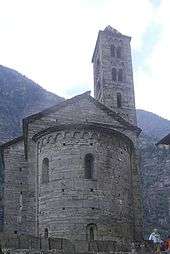
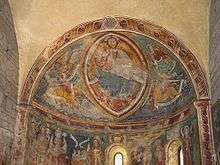
The Caslasc ruins, the Churches of S. Maria del Castello, S. Nicolao, S. Pellegrino and the Torre di Attone are listed as Swiss heritage site of national significance. The entire village of Giornico is part of the Inventory of Swiss Heritage Sites.[13]
Politics
In the 2007 federal election the most popular party was the CVP which received 34.49% of the vote. The next three most popular parties were the FDP (27.61%), the SP (18.54%) and the Ticino League (14.52%). In the federal election, a total of 277 votes were cast, and the voter turnout was 47.5%.[14]
In the 2007 Gran Consiglio election, there were a total of 585 registered voters in Giornico, of which 421 or 72.0% voted. 7 blank ballots were cast, leaving 414 valid ballots in the election. The most popular party was the PPD+GenGiova which received 106 or 25.6% of the vote. The next three most popular parties were; the PLRT (with 97 or 23.4%), the PS (with 72 or 17.4%) and the SSI (with 68 or 16.4%).[15]
In the 2007 Consiglio di Stato election, 3 blank ballots were cast, leaving 419 valid ballots in the election. The most popular party was the PPD which received 108 or 25.8% of the vote. The next three most popular parties were; the PLRT (with 98 or 23.4%), the PS (with 77 or 18.4%) and the LEGA (with 65 or 15.5%).[15]
Economy
As of 2007, Giornico had an unemployment rate of 4.41%. As of 2005, there were 22 people employed in the primary economic sector and about 14 businesses involved in this sector. 204 people were employed in the secondary sector and there were 11 businesses in this sector. 112 people were employed in the tertiary sector, with 26 businesses in this sector.[8] There were 382 residents of the municipality who were employed in some capacity, of which females made up 35.9% of the workforce.
In 2000, there were 133 workers who commuted into the municipality and 258 workers who commuted away. The municipality is a net exporter of workers, with about 1.9 workers leaving the municipality for every one entering.[16] Of the working population, 6% used public transportation to get to work, and 65.7% used a private car.[8]
Religion
From the 2000 census, 778 or 87.9% were Roman Catholic, while 13 or 1.5% belonged to the Swiss Reformed Church. There are 70 individuals (or about 7.91% of the population) who belong to another church (not listed on the census), and 24 individuals (or about 2.71% of the population) did not answer the question.[9]
Education
The entire Swiss population is generally well educated. In Giornico about 59.5% of the population (between age 25-64) have completed either non-mandatory upper secondary education or additional higher education (either university or a Fachhochschule).[8]
In Giornico there were a total of 122 students (as of 2009). The Ticino education system provides up to three years of non-mandatory kindergarten and in Giornico there were 15 children in kindergarten. The primary school program lasts for five years and includes both a standard school and a special school. In the municipality, 33 students attended the standard primary schools and 2 students attended the special school. In the lower secondary school system, students either attend a two-year middle school followed by a two-year pre-apprenticeship or they attend a four-year program to prepare for higher education. There were 33 students in the two-year middle school and 1 in their pre-apprenticeship, while 6 students were in the four-year advanced program.
The upper secondary school includes several options, but at the end of the upper secondary program, a student will be prepared to enter a trade or to continue on to a university or college. In Ticino, vocational students may either attend school while working on their internship or apprenticeship (which takes three or four years) or may attend school followed by an internship or apprenticeship (which takes one year as a full-time student or one and a half to two years as a part-time student).[17] There were 11 vocational students who were attending school full-time and 18 who attend part-time.
The professional program lasts three years and prepares a student for a job in engineering, nursing, computer science, business, tourism and similar fields. There were 3 students in the professional program.[18]
As of 2000, there were 192 students in Giornico who came from another municipality, while 27 residents attended schools outside the municipality.[16]
References
- ↑ Arealstatistik Standard - Gemeindedaten nach 4 Hauptbereichen
- 1 2 Swiss Federal Statistical Office - STAT-TAB, online database – Ständige und nichtständige Wohnbevölkerung nach institutionellen Gliederungen, Geburtsort und Staatsangehörigkeit (German) accessed 30 August 2016
- 1 2 3 4 5 6 7 Giornico in German, French and Italian in the online Historical Dictionary of Switzerland.
- ↑ Braun, Adolphe: Photographische Ansichten der Gotthardbahn, Dornach im Elsass, ca. 1875
- ↑ Altitudine, superficie, secondo il genere di utilizzazione, rilevazione 1992/1997, e densità della popolazione, nel 2000 (Italian) accessed 25 October 2010
- ↑ Flags of the World.com accessed 10-November-2010
- 1 2 Swiss Federal Statistical Office - Superweb database - Gemeinde Statistics 1981-2008 (German) accessed 19 June 2010
- 1 2 3 4 5 6 Swiss Federal Statistical Office accessed 10-November-2010
- 1 2 Popolazione residente, secondo la lingua principale e la religione, nel 2000 (Italian) accessed 23 November 2010
- 1 2 01.02.03 Popolazione residente permanente (Italian) accessed 23 November 2010
- ↑ 09.02.01 Edifici (Italian) accessed 23 November 2010
- 1 2 09.02.02 Abitazioni (Italian) accessed 23 November 2010
- ↑ "Kantonsliste A-Objekte:Ticino" (PDF). KGS Inventar (in German). Federal Office of Civil Protection. 2009. Retrieved 12 July 2010.
- ↑ Swiss Federal Statistical Office, Nationalratswahlen 2007: Stärke der Parteien und Wahlbeteiligung, nach Gemeinden/Bezirk/Canton (German) accessed 28 May 2010
- 1 2 Elezioni cantonali: Gran Consiglio, Consiglio di Stato (Italian) accessed 23 November 2010
- 1 2 Swiss Federal Statistical Office - Statweb (German) accessed 24 June 2010
- ↑ EDK/CDIP/IDES (2010). KANTONALE SCHULSTRUKTUREN IN DER SCHWEIZ UND IM FÜRSTENTUM LIECHTENSTEIN / STRUCTURES SCOLAIRES CANTONALES EN SUISSE ET DANS LA PRINCIPAUTÉ DU LIECHTENSTEIN (PDF) (Report). Retrieved 24 June 2010.
- ↑ Allievi e studenti, secondo il genere di scuola, anno scolastico 2009/2010 (Italian) accessed 23 November 2010
External links
- Giornico in German, French and Italian in the online Historical Dictionary of Switzerland.
| Wikimedia Commons has media related to Giornico. |
